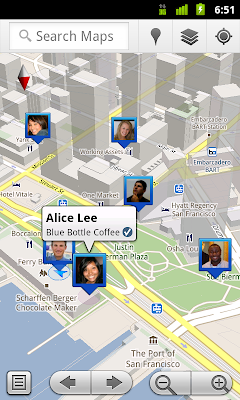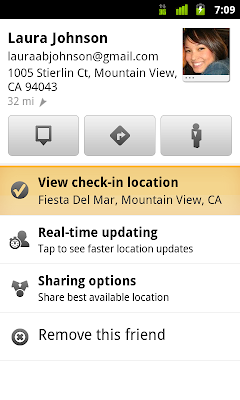Official Google Blog |
- Google Hotpot now on Google.com and around the world
- Microsoft’s Bing uses Google search results—and denies it
- Check in with Google Latitude
| Google Hotpot now on Google.com and around the world Posted: 01 Feb 2011 06:10 PM PST Back in November, we introduced Hotpot, a new local recommendation engine powered by you and your friends. Using Hotpot is simple: you rate places on google.com/hotpot—restaurants, hotels, cafes—and add friends on Hotpot whose opinions you trust. Then the next time you perform a search, Google will serve up personalized results, listing places based on your tastes, as well as recommendations from your friends. We've watched Hotpot grow and change over the last couple months, and today Hotpot is really going places: to a Google search box near you and around the world. You can now enjoy Hotpot recommendations in your regular search results on Google.com. So say you're looking for a restaurant in Barcelona. Go to Google and search [restaurant barcelona]. If a friend has rated a particular restaurant, you might see their rating and what they had to say about it—as well as their name and photo—directly beneath that restaurant's listing. To see all recommendations by your friends, click "Places" on the lefthand side of the page, and choose "Friends only." Remember, you'll need to be logged in to your Google account in order to see recommendations.  Seeing place recommendations based on your tastes and those of your friends across more Google searches will make results more relevant to you and maybe lead you to discover a new gem. If you don't have Hotpot friends yet, you can invite them to share all the places they love with you by using the "Friends" tab on google.com/hotpot. But Hotpot will only be half the fun if you can't share it with all your international friends. So starting today, we're making Hotpot available in 38 new languages—including Chinese, French, German, Italian, Korean, Polish, Russian and Spanish—allowing people to share their favorite places in their native language. Start rating and sharing recommendations with Hotpot everywhere, anytime: at google.com/hotpot, on Google Maps, using Google Maps for Android with an easy widget, and on our new iPhone app. Happy rating! |
| Microsoft’s Bing uses Google search results—and denies it Posted: 01 Feb 2011 02:57 PM PST By now, you may have read Danny Sullivan's recent post: "Google: Bing is Cheating, Copying Our Search Results" and heard Microsoft's response, "We do not copy Google's results." However you define copying, the bottom line is, these Bing results came directly from Google. I'd like to give you some background and details of our experiments that lead us to understand just how Bing is using Google web search results. It all started with tarsorrhaphy. Really. As it happens, tarsorrhaphy is a rare surgical procedure on eyelids. And in the summer of 2010, we were looking at the search results for an unusual misspelled query [torsorophy]. Google returned the correct spelling—tarsorrhaphy—along with results for the corrected query. At that time, Bing had no results for the misspelling. Later in the summer, Bing started returning our first result to their users without offering the spell correction (see screenshots below). This was very strange. How could they return our first result to their users without the correct spelling? Had they known the correct spelling, they could have returned several more relevant results for the corrected query.   We couldn't shake the feeling that something was going on, and our suspicions became much stronger in late October 2010 when we noticed a significant increase in how often Google's top search result appeared at the top of Bing's ranking for a variety of queries. This statistical pattern was too striking to ignore. To test our hypothesis, we needed an experiment to determine whether Microsoft was really using Google's search results in Bing's ranking. We created about 100 "synthetic queries"—queries that you would never expect a user to type, such as [hiybbprqag]. As a one-time experiment, for each synthetic query we inserted as Google's top result a unique (real) webpage which had nothing to do with the query. Below is an example:  To be clear, the synthetic query had no relationship with the inserted result we chose—the query didn't appear on the webpage, and there were no links to the webpage with that query phrase. In other words, there was absolutely no reason for any search engine to return that webpage for that synthetic query. You can think of the synthetic queries with inserted results as the search engine equivalent of marked bills in a bank. We gave 20 of our engineers laptops with a fresh install of Microsoft Windows running Internet Explorer 8 with Bing Toolbar installed. As part of the install process, we opted in to the "Suggested Sites" feature of IE8, and we accepted the default options for the Bing Toolbar. We asked these engineers to enter the synthetic queries into the search box on the Google home page, and click on the results, i.e., the results we inserted. We were surprised that within a couple weeks of starting this experiment, our inserted results started appearing in Bing. Below is an example: a search for [hiybbprqag] on Bing returned a page about seating at a theater in Los Angeles. As far as we know, the only connection between the query and result is Google's result page (shown above).  We saw this happen for multiple queries. For the query [delhipublicschool40 chdjob] we inserted a search result for a credit union:  The same credit union soon showed up on Bing for that query:  For the query [juegosdeben1ogrande] we inserted a page of hip hop bling jewelry:  And the same hip hop bling page showed up in Bing:  As we see it, this experiment confirms our suspicion that Bing is using some combination of:
At Google we strongly believe in innovation and are proud of our search quality. We've invested thousands of person-years into developing our search algorithms because we want our users to get the right answer every time they search, and that's not easy. We look forward to competing with genuinely new search algorithms out there—algorithms built on core innovation, and not on recycled search results from a competitor. So to all the users out there looking for the most authentic, relevant search results, we encourage you to come directly to Google. And to those who have asked what we want out of all this, the answer is simple: we'd like for this practice to stop. |
| Posted: 01 Feb 2011 10:37 AM PST (Cross-posted on the Mobile Blog and LatLong Blog) Connecting your location with places You can still use Latitude to automatically update and share your location, but check-ins let you add context to the location—like captions to a photo. For example, I live in San Francisco but often travel around the world. Until today, sharing my location let friends and family know if I was across the globe or in their neighborhood. Now, check-ins let them see the cool restaurant I'm trying in Taipei or join me for a latte at the cafe nearby. See where your friends are on a map and where they're checking in. Because you can use Latitude to automatically detect your location, we've added a few twists to checking in to make it really easy:
Explore your world one check-in at a time Latitude is built right into Google Maps for Android so check-ins work across Latitude and Maps seamlessly. For example, check in at that new hamburger joint, and you'll see its Place page with reviews to help you order. When friends check in at a place, you can go straight from their Latitude profile to its Place page to learn about it, fire up Google Maps Navigation (Beta) for turn-by-turn directions to them, and more. You can also check in at a favorite place to earn special status there; you'll see if you've become a "Regular," a "VIP" or a "Guru" on its Place page. Keep checking in to hold onto your status or reach the next level. Latitude check-ins are built right into Google Maps and Place pages. Choose options for individual check-ins or turn on and off notifications in the Latitude settings. Start checking in by downloading the latest Google Maps from Android Market (on Android 1.6+; tap here if you're on your phone) and then joining Latitude from the main menu. You can check in everywhere Maps and Latitude are already available. If you're using the new Latitude app for iPhone, you'll see your friends' check-ins, and we'll update the app soon so you can check in too. Just the beginning... Checking in from Latitude is just one step in helping you connect the places you go with the people you care about. We believe in letting you use or share your location however you like, and we're working on making location and check-ins useful in more places—across Google and the web. |
| You are subscribed to email updates from The Official Google Blog To stop receiving these emails, you may unsubscribe now. | Email delivery powered by Google |
| Google Inc., 20 West Kinzie, Chicago IL USA 60610 | |






No comments:
Post a Comment